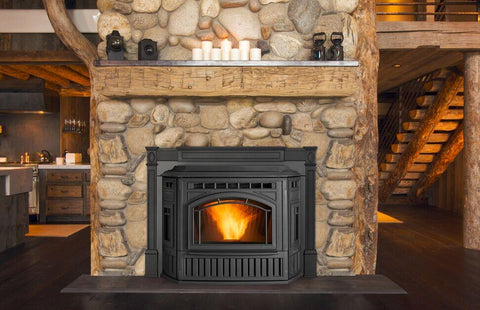With growing interest and prioritization of sustainable living practices, millions of homeowners across the globe are opting for eco-friendly, efficient ways to live. From switching out lightbulbs to reducing water usage, there are simple implementations we all can take to alleviate some of the effects we have on our environment.
Heating your home is no different. Instead of heating methods such as oil, electric or gas, sustainable options such as biomass fuel—pellets and wood—are rising. With rigorous testing for every pellet and wood unit on the market, you can have peace of mind knowing that all current biomass stoves sold today are EPA-certified.
In this blog, we will discuss what EPA certification means, the sustainable benefits of heating with biomass fuels and where to purchase a qualifying stove.
What is the EPA?
The Environmental Protection Agency (EPA) is a U.S. government agency that protects the health and well-being of people and the environment. Since its creation in 1970, the EPA has created regulations, researched environmental issues and published information about their findings to protect Americans, our air, water and land from hazardous environmental risks.
What is an EPA-Certified Stove?
EPA-certification means a pellet or wood stove has passed rigorous emissions and efficiency testing to ensure the heating appliance is safe for consumers and the environment.
This testing measures emissions such as particulate matter, carbon monoxide and other pollutants. Old, uncertified stoves release on average 15 to 30 grams of smoke per hour; whereas new, EPA-certified stoves must limit their emissions to only 4.5 grams of smoke per hour.
How do I know if my stove is EPA-certified?
All EPA-certified stoves will have a white EPA label on the back of the stove. Otherwise, you can look up the stove’s certification status using the EPA’s database.
Benefits of EPA-Certified Stoves

An EPA-certified stove’s benefits extend to many facets of what homeowners care about most. Investing in an EPA-certified wood or pellet stove is a simple switch with considerable positive impacts.
1. Sustainable living
Heating your home using an EPA-certified stove is an impactful first step to living sustainably. Derived from what otherwise would end up as waste in a landfill, pellets are a renewable resource made of manufacturing byproducts such as scrap wood, debris and sawdust.
Like pellets, heating with wood is also a sustainable practice, as trees are a renewable resource. Moreover, when pellets and wood are burned, they produce minimal carbon emissions compared to other heating fuels. By utilizing clean-burning, sustainable energy, homeowners are reducing their carbon footprint.
2. Safety
Compared to old, uncertified stoves, EPA-certified stoves are safer due to their higher efficiency. When a stove operates at a higher efficiency, it uses complete combustion, resulting in less creosote buildup. Creosote, a byproduct of burning wood, lines the interior of the stove and chimney after repeated use. There are many ways to reduce the effects of creosote such as purchasing the right-sized EPA-certified stove, only burning dry, seasoned wood and implementing routine cleaning and maintenance best practices.
3. Energy efficiency

Energy efficiency is not only great for your wallet, but it also has positive environmental impacts. When wood and pellets are burned efficiently, the most heat possible is extracted from them, resulting in less fuel and resource utilization. Furthermore, this high efficiency burn produces less smoke and byproducts in combustion, emitting less carbon into the atmosphere. You can expect pellet and wood stoves with EPA certification to fall into the 70% to 83% efficiency range.
Those with higher efficiencies offer additional technologies, such as Quadra-Fire's Four-Point Burn System. This standard Quadra-Fire technology extends your burn to extract the most heat from your fuel by burning and re-burning the wood, gases and fumes four times. Moreover, Vermont Castings also offers Flexburn Technology, which burn with or without a catalyst and achieve 15% higher efficiency on low burns with the catalyst in place.
Less fuel for longer, warmer and more efficient burns? Count us in.
4. Cost savings
Less fuel means less fuel costs. Thanks to the high efficiency of EPA-certified wood and pellet stoves, you’ll spend less money and time tending to your fire.
Moreover, because pellets and wood are renewable fuel resources, they do not experience price volatility the same way gas and oil do. A study conducted by Pennsylvania State University found that “pellets and cordwood will both result in pretty sizeable savings, relative to fuel oil, in your heating bill. Pellets give the lowest savings, and ‘cut your own’ cordwood gives the greatest savings because it costs the least.”
To learn how much you can save by switching to pellet fuel, visit our pellet fuel cost savings calculator.
5. Consistent heat
Gone are the days of fiddling with your fire. Consistent, warming heat is one of the most significant benefits of investing in a new EPA-certified stove.
Technologies such as Quadra-Fire's Automatic Combustion Control (ACC) manage heat levels and feed the fire with air when you need it most. This technology maintains a steady, lasting fire that extracts the most heat from your wood.
Choosing an EPA-Certified Stove

Know that no matter what stove you are considering, all current pellet and wood stoves on the market are EPA-certified. However, not all stoves are created equally. When choosing a wood or pellet stove, be sure to weigh these considerations:
Price range
- Brand
- BTU (heat) output
- Size (footprint)
- Material (steel or cast iron)
For an in-depth breakdown of how to choose a wood stove, visit this guide.
Federal Biomass Tax Credit
Certain wood and pellet stoves qualify for a federal biomass tax credit. Stoves with “thermal efficiency of at least 75% per the higher heating value (HHV) of the fuel” (Hearth, Patio, and Barbeque Association) qualify for a 30% tax credit of up to $2,000 until December 31, 2032.
Explore Forge & Flame's robust line of qualifying stoves and inserts.
If you want to purchase an EPA-certified stove, you have come to the right place! Forge & Flame offers a robust line of wood and pellet stoves to fit the unique needs of any home. To learn more, visit our collection online or visit one of our certified local dealers.






